How to build brand partnerships that grow your business
If you’re a solopreneur, digital creator, or micro-influencer, chances are that at some point you’ve thought: I’d love to land a brand partnership. And honestly, we applaud that ambition 👏🏽. But if this is your first brand deal, it can feel impossible to know where to even start.
Not long ago, “brand partnerships” often meant free products, a shoutout, or maybe a quick sponsored post. In 2025, that model doesn’t cut it anymore.
Today, the best partnerships are more than one-off deals. They’re built on trust, alignment, and shared goals. And when they click, they can bring steady income, help you grow your audience, and make your community even stronger.
In this guide, you’ll learn everything you need to know about navigating brand partnerships in 2025, from finding and pitching the right brand partner to measuring success.
The new era of brand partnerships is community-first
The traditional model of “collect followers, post ads, hope for clicks” is fading. Now, brands care more about engagement, trust, and community. Niche creators (those with smaller but dedicated audiences) are winning because their communities behave differently: they interact, respond, and believe in what you share.
The stats back it, too. Micro-influencers (10k–100k followers) typically see 3–6% engagement, while big accounts hover closer to 1–2%. On Instagram specifically, micro-creators average 3.86% engagement, compared to 1.21% for larger influencers.
A stronger bond between the creator and their followers is exactly what brands are after when they look for partners. While a campaign with a micro-influencer may reach fewer people overall, those reached are more likely to trust the recommendation, try the product, and share it with others, making these partnerships especially valuable.
In other words, tight-knit communities are becoming the centerpiece of brand partnerships. And for creators, having a dedicated space to connect with their audience—one they fully own—can be a game-changer. That’s where platforms like Circle come in, giving you the freedom to cultivate your community and collaborate with brands on your own terms.
Types of brand partnerships entrepreneurs can explore

Brand partnerships can take many different forms, and you don’t have to stick to just one. In fact, the most successful solopreneurs often mix and match formats based on their audience, goals, and capacity.
Sponsored content
This is the classic partnership: a brand pays you to create content that introduces or demonstrates their product. It could be a video, a podcast mention, or a newsletter feature.
The key? It needs to be relevant to your audience. If your community is for fitness enthusiasts, a partnership with a car insurance company wouldn’t make much sense. But teaming up with a supplement brand, an activewear company, or a fitness app would fit naturally.
Take an example of Ali Abdaal, Productivity Lab founder and doctor-turned-YouTuber. He started his channel in 2017, and it has since grown to millions of subscribers. Today, he monetizes through sponsored video content, ads, and channel memberships with partners like Circle, Notion, Claude, Lovable, and Paperlike, among others.
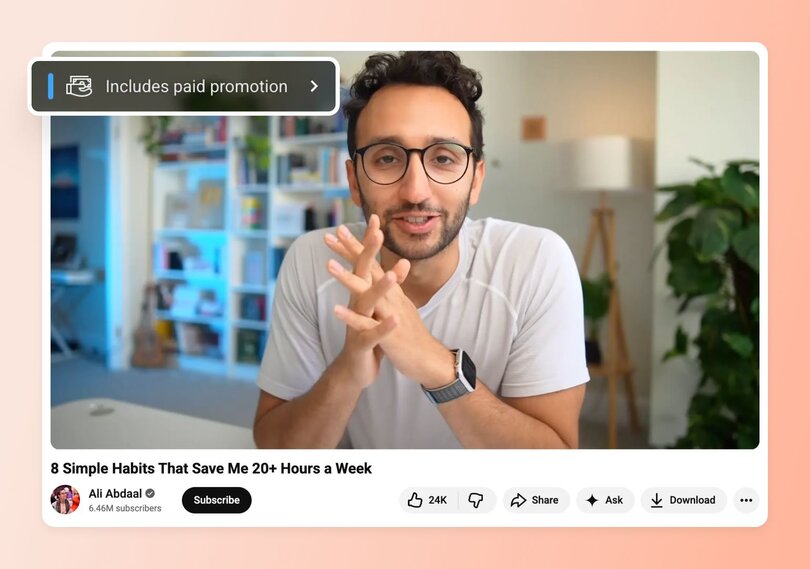
Joint events and challenges
Another way to partner with a brand is through joint events and community challenges. These are collaborations where you and a brand come together to host an experience for your collected audiences.
Unsurprisingly, events and challenges create the most interaction in your community. Your audience gets free, useful content, and the brand gets to connect with people who are already interested in their product. Everyone walks away with something of value.
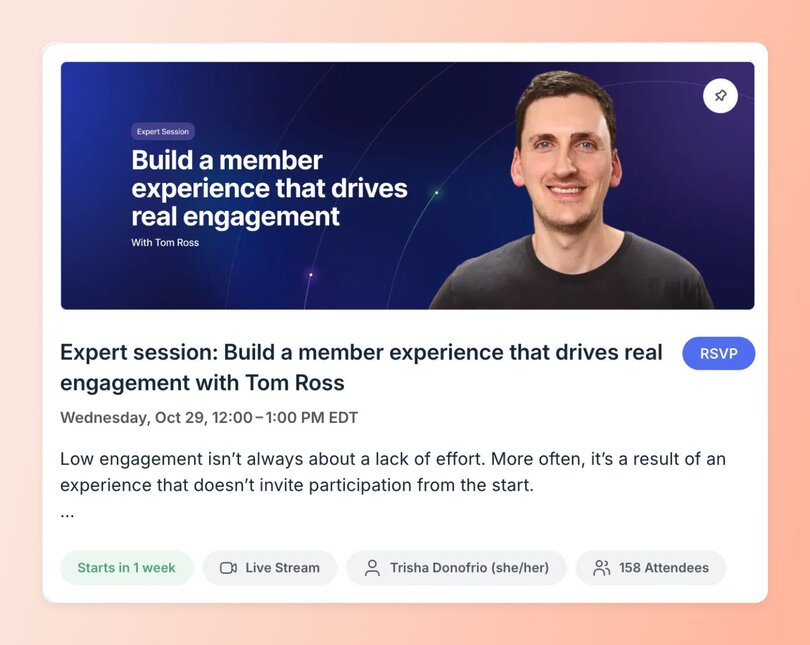
For example, in the Circle customer community, we host masterclasses with our expert contributors—who are usually community experts with their own businesses. Miro similarly runs member-led events with consultant advocates, and other enterprise partners.
Co-branded digital products or bundles
Co-branded digital products or bundles are resources you create together with a brand, like an eBook, a toolkit, or a course add-on that carries both of your names.
The benefit is that your audience gets something practical and exclusive, while the brand gains credibility by being tied to a trusted creator.
Affiliate partnerships with exclusive codes
Affiliate partnerships let you earn a commission whenever someone in your community buys a product through your link. A simple way to make this even more valuable is by offering your members an exclusive discount code.
The benefit is twofold: your community gets access to special deals, and you get rewarded for recommending products you genuinely believe in.
A good example of affiliate marketing in action is Podcraft. They monetize their podcast by using affiliate links to direct people to their favorite equipment for purchase.
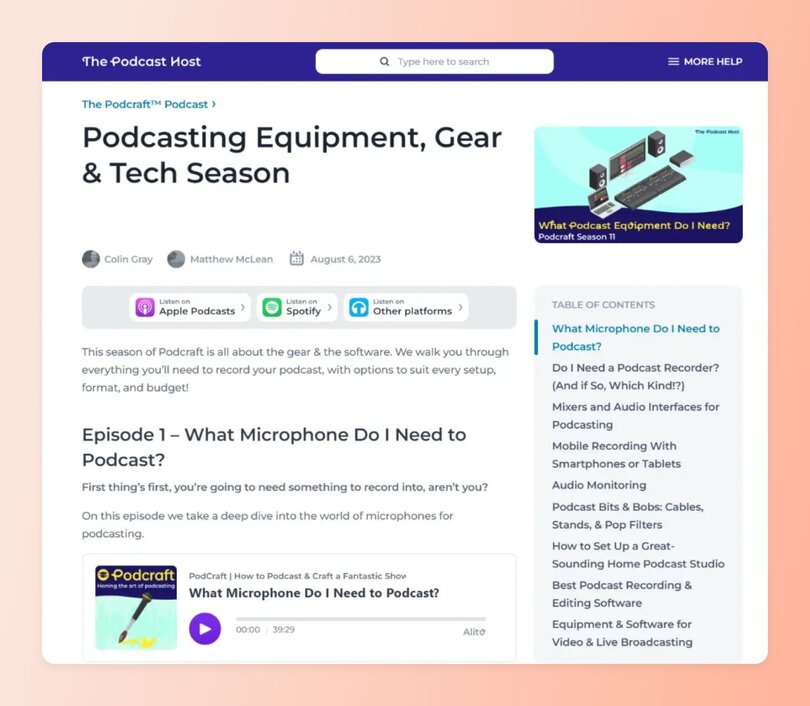
White-labeled content collaborations
Sometimes, when the brand alignment, values, and audience overlap in a perfect way, you’ll want to consider a “white-labeled collab”. White-labeled content collaborations are when a brand contributes directly to something you’re already offering, like adding a module to your course or co-hosting a workshop inside your community.
You should only tackle these collaborations when there’s minimal risk to either brand, because the product just gets stronger with both teams.
How to find and pitch the right brand partner in 4 steps
Alright, let’s get down to the practical stuff—how to actually find and pitch the right brand partner for your business. Here’s a simple 4-step process👇
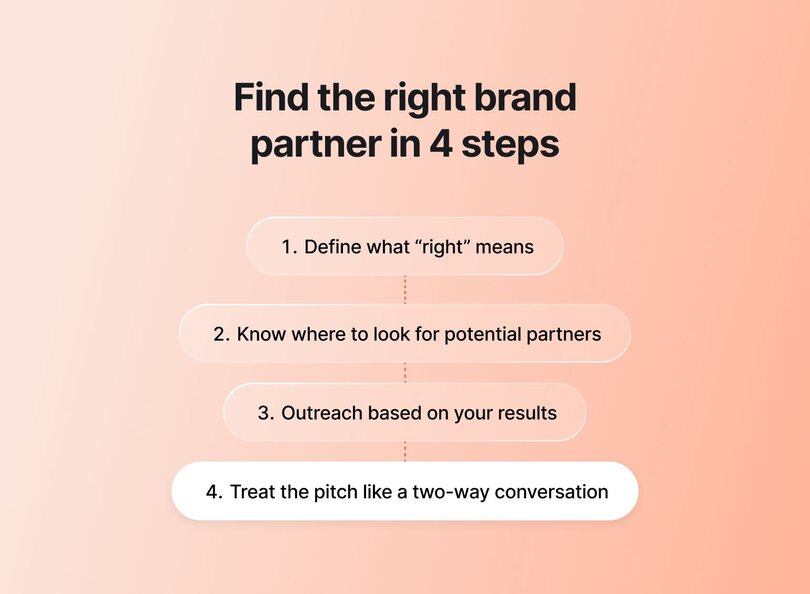
Step 1: Define what “right” means
Before you start reaching out, get clear on what the “right” partner really looks like. The best partnerships work on two levels: they feel aligned with you as a creator (or your business), and they make sense for your audience. Miss either side, and the collaboration will come across as forced.
Here are a few angles to lock in:
- Shared values: Does the brand believe in the same things you and your community stand for? Do they show up consistently in the way they market and operate, not just in slogans?
- ICP overlap: Your ideal customer profile (ICP) should overlap with theirs. If your members are early-stage founders and the brand is selling enterprise software, the gap will be too wide for anyone to benefit.
- Stage alignment: Big, established brands often look for large-scale activations. If your community is still growing, a smaller startup may be a better fit—they’ll be more flexible, and the partnership can grow alongside you.
Justin Moore, a leading sponsorship coach who has personally made $5M+ through brand partnerships (and founder of Creator Wizard), believes that brand–audience alignment is the #1 factor in the success of a partnership:
“The only thing that matters is audience alignment with the brand. If you don’t have real, quantifiable evidence that your audience will be stoked to learn about this product or service, you should not take the deal.”
🧪 The litmus test is simple: would this brand bring genuine value to your members, while also benefiting from the trust you’ve built with them? If the answer is yes on both fronts, you’ve found the right kind of partner to pursue.
Step 2: Know where to look for potential partners
Once you’ve defined what the “right” partner looks like, the next step is figuring out where to find them. A great place to start is your own community—maybe one of your members runs a brand that aligns perfectly and is already open to collaborating.
Other good places to check out:
- LinkedIn: Look up a potential brand you'd love to work with and search for roles Head of Partnerships or Community Manager to see if they’re investing in collabs.
- Founder or influencer groups: Niche Slack communities often have partnership threads where brands scout for creators.
- Dedicated platforms: Marketplaces like Pearpop, GRIN, and Afluencer can help you discover brands actively looking for community partners.
- Places you/your audience hangs out: Maybe your audience isn’t the LinkedIn crowd, but instead they’re on Ravelry (for knitters), or Discord. Maybe everyone in your community listens to a murder podcast 🤷—don’t write it off! Take a look to see who else is sponsoring their content and think through whether there’s overlap.
Step 3: Outreach based on your results
After you’ve identified a potential partner, it’s time to reach out! What you say and how you say it can determine whether the conversation goes anywhere.
Two approaches tend to work best:
- The warm intro: Instead of emailing a brand rep out of the blue, see if someone in your professional network can connect you. Maybe a past client knows their marketing lead, or a friend of a friend works on their partnerships team. Even a short LinkedIn or email intro from a mutual contact makes the outreach feel more credible and increases the chance of a reply.
- Pitching your flywheel: In your pitch deck or outreach email, lead with your community’s audience insights (who your members are) and engagement data (how they participate). For example, share turnout rates for events or how many members join via referrals. Your goal is to prove to the brand that they would be stepping into an active, engaged, and self-sustaining ecosystem.
Another tip Alexis Teichmiller, Circle’s Sr. Partnerships Manager, shares:
“One of the biggest missed opportunities I see is that solopreneurs often overlook the small, easy wins that build credibility and trust quickly.
Creating a simple media kit or one-pager with audience insights and engagement stats instantly elevates their professionalism. Adding even one or two case studies—showing how a past collab performed or how their content drives results—goes a long way in building confidence with a brand.”
Step 4: Treat the pitch like a two-way conversation
While how you prepare and deliver your pitch is important, ultimately, brand partnerships are about relationships.
On the other side, there’s a brand with its own priorities, goals, and challenges, so you need to be open to listening as much as presenting. That might mean adjusting your idea to match a product launch timeline, or reframing your proposal around the audience segment they care about most.
“Treating the pitch as a two-way conversation—through an informal interview or alignment call—helps both sides find common ground and set the stage for a stronger partnership.”
– Alexis Teichmiller, Circle’s Sr. Partnerships Manager
Pricing & negotiation tips for first-time partners
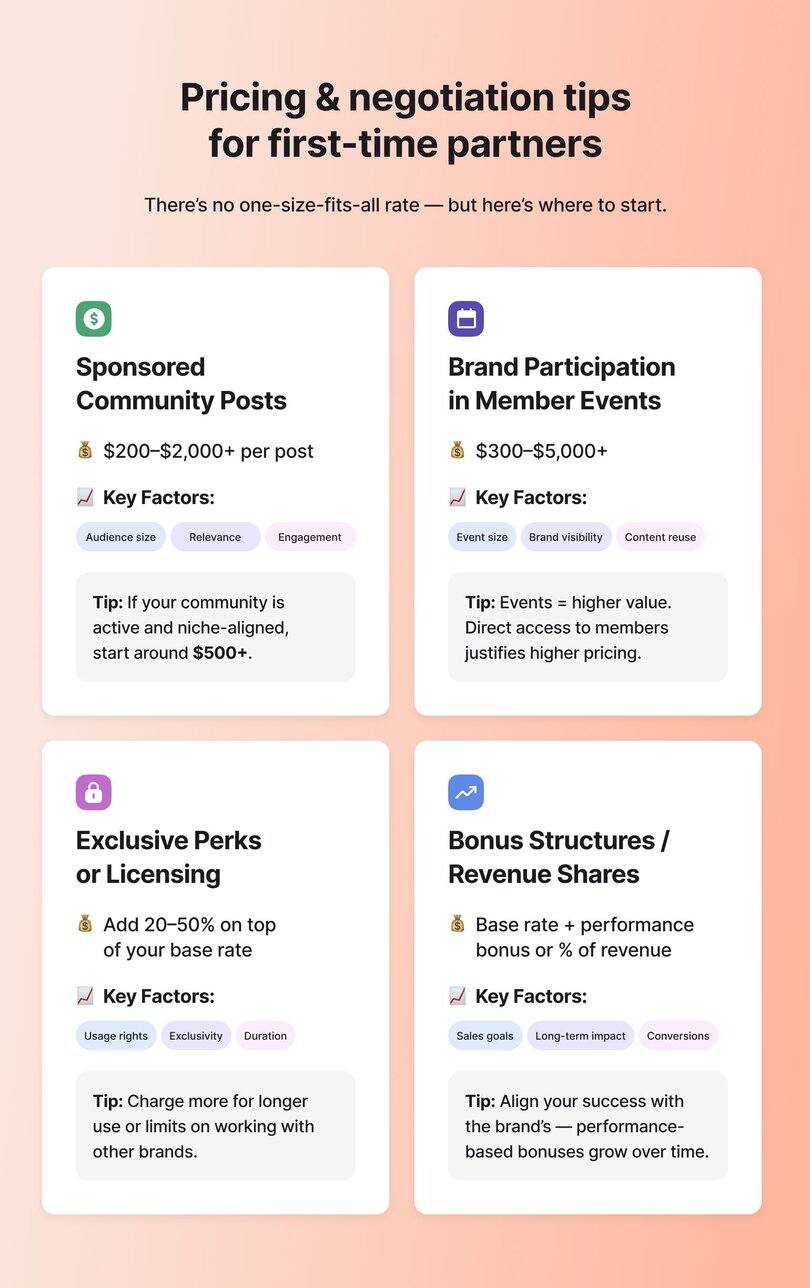
How much to charge for community brand partnerships is a tough question, because there isn’t one “right” number. It depends on your niche, the size and activity of your audience, the brand’s budget, and a zillion other factors.
Still, we can offer you a couple of helpful benchmarks and pointers that can make pricing feel a little easier to figure out.
How much to charge for: Sponsored community posts
A 2025 study by Favikon on sponsored LinkedIn posts found that most content creators charged between $200 and $2,000 per post, depending on factors like audience size, engagement rate, and niche. Outliers ranged from as little as $10 to as much as $7,500, but the majority sat in that mid-range.
Of course, your community isn’t quite LinkedIn, but we can say that a similar principle applies. What brands really pay for is relevance and trust. If your members are active and closely aligned with a brand’s ideal customer, a sponsored post in your community can realistically start around $500+ and grow from there.
How much to charge for: Brand participation in member events
Events, like workshops, AMAs, or summits, are often worth more than static posts because they give brands direct access to your members. Pricing here should reflect the level of exposure: a small workshop might be a few hundred dollars, while a large community-wide summit could justify $1,000–$5,000+, especially if you provide recordings or repurpose the content afterward.
How much to charge for: Exclusive perks or licensing
If a brand wants more than a one-off partnership, like exclusive perks for your community or the rights to keep using your content, you should consider adding a “usage rights” fee.
Most creators handle this by charging a percentage on top of their base rate, usually 20–50% per month of use. The bigger the brand’s ask (longer timeframes, multiple platforms, or exclusivity that prevents you from working with competitors), the higher your fee should go.
💡 Alexis recommends being upfront about pricing in your pitch: “I also recommend being upfront by including pricing in your pitch; it saves everyone time and accelerates decision-making.”
How much to charge for: Bonus structures or long-term revenue shares
Another smart way to grow beyond flat rates is by building in performance-based bonuses or revenue shares. For example, you could set a base rate for a campaign and add a bonus if the brand hits certain signup or sales goals. Another option is negotiating a small revenue share on subscriptions or products sold through your community over time.
How to activate your community during a brand partnership
The difference between a forgettable sponsorship and a meaningful brand partnership often comes down to how you bring your community into the experience. Members can spot a “salesy” plug a mile away, and that’s something you don’t really want.
Instead, you should invite them to participate; that way, the partnership feels natural and valuable. Here are a few ways to do that:
- Behind-the-scenes content and real-time builds: It’s a good idea to involve your community in the process of working with a brand. Share updates as you test, experiment, or build something new together. This makes members feel like insiders and gives them a sense of ownership in the journey, which strengthens both their trust in you and their connection to the brand.
- Polls, feedback, and community Q&As: Don’t make assumptions about what your members want. Ask them directly. Polls and Q&As let your audience shape the partnership itself, while giving the brand meaningful insight into their real needs.
- Member-only AMAs or live events: You should also bring your partner into your community through live experiences. Consider organizing a Q&A, workshop, or demo to give your members the chance to learn directly from the people behind the product, not just read about it.
How to measure success
Success looks different for every brand partnership, which is why you need to define your KPIs before the campaign starts. Are you aiming for reach and impressions, conversions and signups, or deeper engagement within your community? Defining this upfront makes it easier to know what worked and what didn’t.
💡Pro insight: The real strength of community partnerships is that their value compounds over time. They don’t just create one spike in visibility—they build trust and deepen relationships that can grow your business long-term.
Tools & platforms to get started with brand partnerships
You don’t need a big team or fancy setup to manage brand partnerships. With just a couple of tools, you can find partners, run campaigns, and stay organized. A much bigger question is whether you should use partnership marketplaces or do cold outreach yourself.
Marketplaces vs. DIY outreach
If you’re just starting out, partnership marketplaces can help connect you with brands that are actively looking for creators. The trade-off is that competition is high, and the deals are often smaller or short-term.
Once you’ve built a clear pitch and have some results to show, DIY outreach (reaching out directly to brands or their partnership managers) can lead to bigger, longer-term deals.
Tools to help you land partnerships
- GRIN: A creator management platform that helps influencers connect with brands, manage campaigns, and handle payments in one place.
- Pearpop: A marketplace where creators of all sizes can get paid to collaborate with brands on social media campaigns.
- Afluencer: A matchmaking app that pairs micro-influencers with brands looking for niche audiences and affordable partnerships.
- Circle: Not just for hosting your community, but also for showing brands hard data on engagement. With integrations into your CRM or analytics, you can pull real numbers on participation, event attendance, and member activity to strengthen your pitch.
Tools to manage your campaigns
Whether you’re pitching to brands or managing partnerships you’ve already landed, a simple tracker can help you stay on top of the details. Instead of juggling everything in your head, you can keep a record of things like:
- Who you reached out to and when
- Follow-ups you’ve sent (and what’s still pending)
- Contracts you’ve signed
- The value of each partnership
- How long the partnership runs
- Key deliverables and deadlines
Using a basic tracker in Notion or Google Sheets makes it easy to see where each partnership stands and what needs your attention next.
Ready for your first brand deal?
The future of brand partnerships is co-created. You don’t need 100,000 followers or a massive production budget to land your first deal. What brands care about most is a deeply engaged community, which is real people who trust you and value what you share. That’s the advantage you already have.
Interested in co-creating brand experiences inside your own community? Start building on Circle for free and see how easy it is to bring brands and members together in one space that’s fully yours.
FAQs about brand partnerships within communities
What is a brand partnership?
A brand partnership is when a creator and a company work together in a way that benefits both sides. The brand gets exposure to a trusted audience, and the creator gets paid or supported for sharing something that fits their community.
Many people confuse brand partnerships with sponsorships or simple collaborations. The terms get tossed around a lot, but they’re not quite the same thing.
Brand partnership vs. sponsorship:
A sponsorship is usually one-sided. The brand pays you to promote them, but it’s often a short-term deal, like a single post or event mention. A partnership is more long-term and built on shared goals.
Brand partnership vs. collaboration:
A collaboration can be very casual, like doing a one-off video or giveaway together between two fledgling creators. A brand partnership is more formal, often with clear expectations, contracts, and ongoing campaigns.
How do brand deals work for small creators?
As a small creator, you probably won’t land a big money deal right out of the gate—and that’s totally fine. The best way to start is by using partnership marketplaces like GRIN, Pearpop, or Afluencer. They’re great because brands on these platforms are already looking for creators like you.
After working with a couple of brands through these platforms, consider reaching out to companies directly. Create a tailored pitch, gather stats about your social community engagement, and use the results from your past campaigns to prove your value to potential partners. Be prepared to send several outreach messages, and don’t get discouraged if you hear a couple of “no’s” along the way. You might not be the right fit for those companies now, but you could be in the future.
How much should I charge for a community-sponsored post?
There’s no flat rate—it depends on the size and activity of your community and how much visibility the brand will get. For small, niche communities, rates often start around $200–$400 per post. For larger or highly engaged communities, it’s common to charge $500 and upwards, especially if your audience has strong purchasing power.
One way to think about it is: how much would that brand normally pay for ads to reach the same number of people with the same level of engagement?
Another tip: look at your sponsor’s potential return. If even a small percentage of your audience buys, how much revenue would that bring them? That can help you set a fair starting price. You can also check what other creators with similar stats are charging to avoid undervaluing yourself. If you’re just starting, it’s okay to charge less for a test campaign and raise your rates once you can show results.